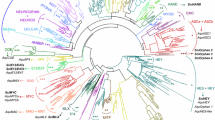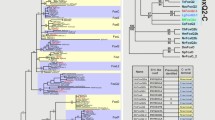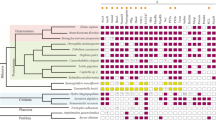Abstract
Hairy-related basic helix-loop-helix (bHLH) transcription factors are targets of Delta-Notch signaling and represent essential components for a number of cell fate decisions during vertebrate embryogenesis. Hey genes encode a subfamily of hairy-related proteins that have been implicated in processes like somitogenesis, blood vessel and heart development. We have identified and characterized hey genes in three teleost fish lineages using degenerate PCR and database searches. Phylogenetic analysis of Hey proteins suggests a complex pattern of evolution with high divergence of hey2 in Takifugu rubripes (Fugu, Japanese pufferfish) and possibly loss in the related Tetraodon nigroviridis (the freshwater pufferfish). In addition, duplication of hey1 in both pufferfishes, Fugu and Tetraodon, was observed. Conversely, zebrafish (Danio rerio) has the same complement of three hey genes as known from mammals. All three hey genes show much more restricted gene expression profiles in zebrafish when compared to mouse. Importantly, while all three murine Hey genes are expressed in overlapping patterns in the presomitic mesoderm (PSM) and somites, in zebrafish only hey1 shows PSM and somite expression in a highly dynamic fashion. Therefore, while overlapping expression might account for redundancy of hey function in higher vertebrates, this is unlikely to be the case in zebrafish. In deltaD (dlD) deficient after-eight zebrafish mutants, the dynamic expression of hey1 in the PSM is impaired and completely lost in newly formed somitomeres. Overexpression of dlD on the other hand results in the ectopic expression of hey1 in the axial mesoderm. Hence, hey1 represents a target of Delta-Notch signaling dynamically expressed during somite formation in zebrafish.





Similar content being viewed by others
References
Aparicio S, Chapman J, Stupka E, Putnam N, Chia JM, Dehal P, Christoffels A, et al (2002) Whole-genome shotgun assembly and analysis of the genome of Fugu rubripes. Science 297:1301–1310
Chen JN, Fishman MC (1996) Zebrafish tinman homolog demarcates the heart field and initiates myocardial differentiation. Development 122:3809–3816
Chin MT, Maemura K, Fukumoto S, Jain MK, Layne MD, Watanabe M, Hsieh CM, Lee ME (2000) Cardiovascular basic helix loop helix factor 1, a novel transcriptional repressor expressed preferentially in the developing and adult cardiovascular system. J Biol Chem 275:6381–6387
Dawson SR, Turner DL, Weintraub H, Parkhurst SM (1995) Specificity for the hairy/enhancer of split basic helix-loop-helix (bHLH) proteins maps outside the bHLH domain and suggests two separable modes of transcriptional repression. Mol Cell Biol 15:6923–6931
Donovan J, Kordylewska A, Jan YN, Utset MF (2002) Tetralogy of fallot and other congenital heart defects in Hey2 mutant mice. Curr Biol 12:1605–1610
Dornseifer P, Takke C, Campos-Ortega JA (1997) Overexpression of a zebrafish homologue of the Drosophila neurogenic gene Delta perturbs differentiation of primary neurons and somite development. Mech Dev 63:159–171
Felsenstein J (1985) Confidence limits on phylogenies: an approach using the bootstrap. Evolution 39:783–791
Fischer A, Leimeister C, Winkler C, Schumacher N, Klamt B, Elmasri H, Steidl C, Maier M, Knobeloch KP, Amann K, Helisch A, Sendtner M, Gessler M (2002) Hey bHLH factors in cardiovascular development. Cold Spring Harb Symp Quant Biol 67:63–70
Gajewski M, Voolstra C (2002) Comparative analysis of somitogenesis related genes of the hairy/Enhancer of split class in Fugu and zebrafish. Genomics 3:21
Gessler M, Knobeloch KP, Helisch A, Amann K, Schumacher N, Fischer A, Leimeister C (2002) Mouse gridlock: No aortic coarctation or deficiency, but fatal cardiac defects in Hey2-/- mice. Curr Biol 12:1601–1604
Holley SA, Geisler R, Nüsslein-Volhard C (2000) Control of her1 expression during zebrafish somitogenesis by a Delta-dependent oscillator and an independent wave-front activity. Genes Dev 14:1678–1690
Holley SA, Jülich D, Rauch GJ, Geisler R, Nüsslein-Volhard C (2002) Her1 and the notch pathway function within the oscillator mechanism that regulated zebrafish somitogenesis. Development 129:1175–1183
Iso T, Sartorelli V, Chung G, Shichinonhe T, Kedes L, Hamamori Y (2001a) HERP, a new primary target of Notch regulated by ligand binding. Mol Cell Biol 21:6071–6079
Iso T, Sartorelli V, Poizat C, Iezzi S, Wu HY, Chung G, Kedes L, Hamamori Y (2001b) HERP, a novel heterodimer partner of HES/E(spl) in notch signaling. Mol Cell Biol 21:6080–6089
Kimmel CB, Ballard WW, Kimmel SR, Ullmann B, Schilling TF (1995) Stages of embryonic development of the zebrafish. Dev Dyn 203:253–310
Kokubo H, Lun Y, Johnson RL (1999) Identification and expression of a novel family of bHLH cDNAs related to Drosophila hairy and enhancer of split. Biochem Biophys Res Commun 260:459–465
Kumar S, Hedges SB (1998) A molecular timescale for vertebrate evolution. Nature 392:917–920
Leimeister C, Externbrink A, Klamt B, Gessler M (1999) Hey genes: a novel subfamily of hairy- and Enhancer of split related genes specifically expressed during mouse embryogenesis. Mech Dev 85:173–177
Leimeister C, Schumacher N, Steidl C, Gessler M (2000a) Analysis of HeyL expression in wild-type and Notch pathway mutant mouse embryos. Mech Dev 98:195–203
Leimeister C, Dale K, Fischer A, Klamt B, Hrabe de Angelis M, Radtke F, McGrew MJ, Pourquie O, Gessler M (2000b) Oscillating expression of c-hey2 in the presomitic mesoderm suggests that the segmentation clock may use combinatorial signaling through multiple interacting bHLH factors. Dev Biol 227:91–103
Lin MH, Leimeister C, Gessler M, Kopan R (2000) Activation of the Notch pathway in the hair cortex leads to aberrant differentiation of the adjacent hair-shaft layers. Development 127:2421–2432
Lynch M, Conery JS (2000) The evolutionary fate and consequences of duplicate genes. Science 290:1151–1155
Maier MM, Gessler M (2000) Comparative analysis of the human and mouse Hey1 promoter: Hey genes are new Notch target genes. Biochem Biophys Res Commun 275:652–660
Meyer A, Schartl M (1999) Gene and genome duplications in vertebrates: the one-to-four (-to-eight in fish) rule and the evolution of novel gene functions. Curr Opin Cell Biol 11:699–704
Nakagawa O, Nakagawa M, Richardson JA, Olson EN, Srivastava D (1999) HRT1, HRT2, and HRT3: a new subclass of bHLH transcription factors marking specific cardiac, somitic, and pharyngeal arch segments. Dev Biol 216:72–84
Nasevicius A, Ekker SC (2000) Effective targeted gene ‘knockdown’ in zebrafish. Nat Genet 26:216–220
Oates AC, Ho RK (2002) Hairy/E(spl)-related (Her) genes are central components of the segmentation oscillator and display redundancy with the Delta-Notch signaling pathway in the formation of anterior segmental boundaries in the zebrafish. Development 129:2929–2946
Pichon B, Taelman V, Kricha S, Christophe D, Bellefroid EJ (2002) XHRT-1, a hairy and Enhancer of split related gene with expression in floor plate and hypochord during early Xenopus embryogenesis. Dev Genes Evol 212:491–495
Pourquie O, Tam PP (2001) A nomenclature for prospective somites and phases of cyclic gene expression in the presomitic mesoderm. Dev Cell 1:619–620
Roest Crollius H, Jaillon O, Bernot A, Dasilva C, Bouneau L, Fischer C, Fizames C, Wincker P, Brottier P, Quetier F, Saurin W, Weissenbach J (2000) Estimate of human gene number provided by genome-wide analysis using Tetraodon nigroviridis DNA sequence. Nat Genet 25:235–238
Rones MS, Woda J, Mercola M, McLaughlin KA (2002) Isolation and characterization of Xenopus Hey-1: a downstream mediator of Notch signalling. Dev Dyn 255:554–560
Saitou N, Nei M (1987) The neighbor-joining method: a new method for reconstructing phylogenetic trees. Mol Biol Evol 4:406–425
Sakata Y, Kamei CN, Nakagami H, Bronson R, Liao JK, Chin MT (2002) Ventricular septal defect and cardiomyopathy in mice lacking the transcription factor CHF1/Hey2. Proc Natl Acad Sci USA 99:16197–16202
Schmidt HA, Strimmer K, Vingron M, von Haeseler A (2002) TREE-PUZZLE: maximum likelihood phylogenetic analysis using quartets and parallel computing. Bioinformatics 18:502–504
Stainier DYR, Lee RK, Fishman MC (1993) Cardiovascular development in the zebrafish. I. Myocardial fate map and heart tube formation. Development 119:31–40
Strimmer K, von Haeseler A (1996) Quartet puzzling: a quartet maximum likelihood method for reconstructing tree topologies. Mol Biol Evol 13:964–969
Takke C, Campos-Ortega JA (1999) Her1, a zebrafish pair-rule like gene, acts downstream of notch signalling to control somite development. Development 126:3005–3014
Thompson JD, Gibson TJ, Plewniak F, Jeanmougin F, Higgins DG (1997) The ClustalX windows interface: flexible strategies for multiple sequence alignment aided by quality analysis tools. Nucleic Acids Res 24:4876–4882
Westerfield M (1993) The zebrafish book. University of Oregon Press, Eugene
Winkler C, Moon RT (2001) Zebrafish mdk2, a novel secreted midkine, participates in posterior neurogenesis. Dev Biol 229:102–118
Winkler C, Schäfer M, Duschl J, Schartl M, Volff JN (2003) Functional divergence of two zebrafish midkine growth factors following fish-specific gene duplication. Genome Res 13:1067–1081
Wittbrodt J, Meyer A, Schartl M (1998) More genes in fish? BioEssays 20:511–515
Zhong TP, Rosenberg M, Mohideen MA, Weinstein B, Fishman MC (2000) gridlock, an HLH gene required for assembly of the aorta in zebrafish. Science 287:1820–1824
Zhong TP, Childs S, Leu JP, Fishman MC (2001) Gridlock signalling pathway fashions the first embryonic artery. Nature 414:216–220
Acknowledgements
We thank Jose Campos-Ortega for kindly providing the DeltaD expression construct, Artemis for providing the after-eight zebrafish mutants, Cordula Neuner for perfect technical assistance and Cornelia Leimeister and Matthias Schäfer for critical comments on the manuscript. We are also extremely grateful to Laurence Bouneau and the other members of the Tetraodon Genome project (Genoscope, Evry, France) for identifying and providing T. nigroviridis hey sequences. (Taki)Fugu data have been provided freely by the Fugu Genome Consortium for use in this publication only. We especially thank Manfred Schartl for his critical comments and support. This work was supported by the Deutsche Forschungsgemeinschaft (Ge539/9 and SFB 465). J.N.V. is supported by the BioFuture program of the German Bundesministerium für Bildung und Forschung (BMBF).
Author information
Authors and Affiliations
Corresponding author
Additional information
Edited by D. Tautz
Rights and permissions
About this article
Cite this article
Winkler, C., Elmasri, H., Klamt, B. et al. Characterization of hey bHLH genes in teleost fish. Dev Genes Evol 213, 541–553 (2003). https://doi.org/10.1007/s00427-003-0360-6
Received:
Accepted:
Published:
Issue Date:
DOI: https://doi.org/10.1007/s00427-003-0360-6




